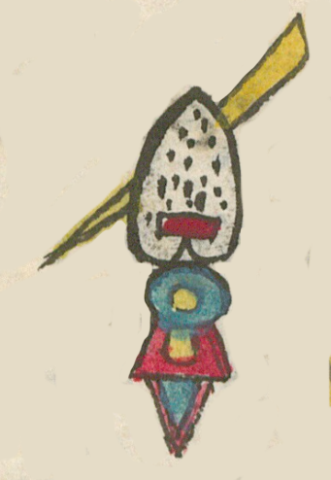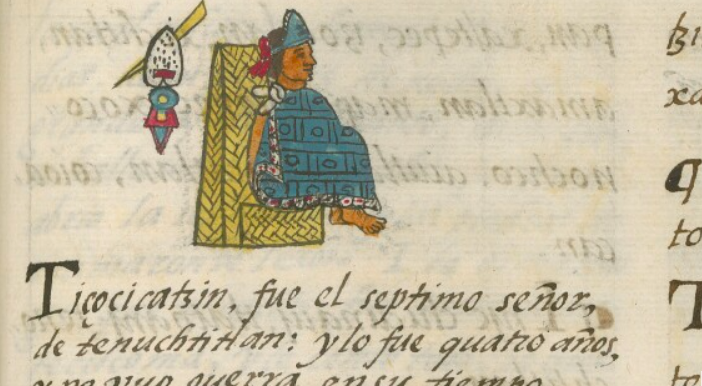Tizocicatl (FCbk8f2r)
This colorfully painted compound glyph represents the personal name, Tizocicatl (perhaps one who makes sacrificial penitence), the name of a ruler of Tenochtitlan. Part of the glyph is a white hill covered with black dots. These dots represent chalk (tizatl), providing the start to the name, Tiz-. The yellow, sharp-pointed item behind the white hill may be a bone for sewing (zozo), almost making the chalk look like a piece of fabric (zotl) that is being sewn with the needle. Thus, one or both of these elements provide the -zo- in the middle of the name. If the name originally included the -cica (or -tzica) ending, which sometimes got shortened to -cic, then perhaps that part is also represented by the sewing, which can result in things being fastened together (tzicatica). Below the white hill is a multi-colored ornament, perhaps an earring that was associated with the ruler. It is red, turquoise, blue, purple, and yellow.
Stephanie Wood
It is possible that the tizatl is a phonetic indicator for tezoc (bloodletter), making this compound entirely phonographic. What appears to be a needle could be a thorn for self-sacrifice through bleeding. Compare this compound with other glyphs for Tizocic (or Tizocicatl) that are also included in this collection, below. Chalk and sewing are inconsistently present. The possible earring is not yet appearing in any of the other glyphs in the collection. Incidentally, many observers shorten the name of this ruler to Tizoc, but Gordon Whittaker makes a case for Tizocic. And several sources provide the longer version, Tizocicatl or Tizocicatzin.
Stephanie Wood
Tiçocicatzin
Tizocicatzin
Stephanie Wood
1577
Jeff Haskett-Wood
arete, aretes, pendiente, pendientes, coser, aguja, agujas, tiza, tlahtoani, tlatoani, tlahtohqueh, tlatoque, tecuhtli, tecutli, teuctli, gobernadores, goernador, gobernante, gobernantes, tlatoque, nombres, sacrificios, penitencias, nombres de hombres

Tizocicatl, seventh ruler of Mexico Tenochtitlan, https://nahuatl.wired-humanities.org/content/tizocicatl
tiza(tl), chalk or white wash, https://nahuatl.wired-humanities.org/content/tizatl
tzicatica, fastening or sticking things together, https://nahuatl.wired-humanities.org/content/tzicatica
zozo, to string things together, sew, https://nahuatl.wired-humanities.org/content/zozo
zo(tl), a piece of cloth, https://nahuatl.wired-humanities.org/content/zotl
tezoc, a bloodletter, https://nahuatl.wired-humanities.org/content/tezoc
posiblemente, Él Que Hace Sacrificios o Penitencias (nombre de un emperador)
Stephanie Wood
Available at Digital Florentine Codex/Códice Florentino Digital, edited by Kim N. Richter and Alicia Maria Houtrouw, "Book 8: Kings and Lords", fol. 2r, Getty Research Institute, 2023. https://florentinecodex.getty.edu/en/book/8/folio/2r/images/0 Accessed 20 June 2025.
Images of the digitized Florentine Codex are made available under the following Creative Commons license: CC BY-NC-ND (Attribution-NonCommercial-NoDerivs 4.0 International). For print-publication quality photos, please contact the Biblioteca Medicea Laurenziana ([email protected]). The Library of Congress has also published this manuscript, using the images of the World Digital Library copy. “The Library of Congress is unaware of any copyright or other restrictions in the World Digital Library Collection. Absent any such restrictions, these materials are free to use and reuse.”




